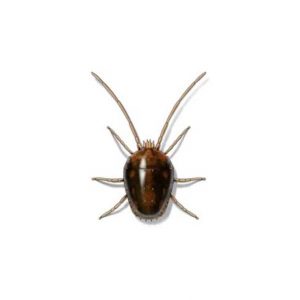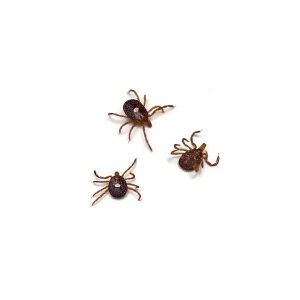What Is a Flea?
Fleas are small, wingless insects that can cause discomfort and potential health risks to humans and animals. They are parasites that feed on the blood of mammals and birds, using their specialized mouthparts to pierce the skin of their hosts. Fleas are notorious for their ability to jump long distances, making them excellent at moving from one host to another.
What Do Fleas Look Like?
Fleas are tiny, typically measuring 1.5 to 3.3 mm in length. Their bodies are flat and reddish-brown, allowing them to move quickly through the fur of animals. They have long legs, with the hind pair being well-adapted for jumping. Fleas are wingless and have a hard exoskeleton. Their bodies are also covered in tiny hairs and spines, which help them grip their host. Adult fleas are the most common stage observed, but it’s essential to recognize flea eggs, larvae, and pupae to understand a flea infestation fully.
Habitat
What Attracts Fleas?
Fleas are primarily attracted to warmth, carbon dioxide, and the presence of a potential host. Warm-blooded animals, such as dogs, cats, rodents, and humans, are ideal targets. Fleas are also drawn to environments where their hosts spend time, such as bedding, carpets, and pet resting areas. Fleas thrive in many climates but prefer moist, humid, and shady areas. The area underneath a porch or deck can turn into an overwintering site. Areas with tall grass, leaf litter, weeds, wood piles, gravelly spots, and sandy patches are all attractive to fleas. Even the tiniest crack in the concrete can harbor fleas, and they especially like shrubs, leaves, and trees, although they do not fare well in sunny areas or open grass.
Where Do Fleas Live?
Fleas typically live on their host, but they can also be found in the areas where their host sleeps or spends a lot of time. Flea larvae do not like light, so carpets, bedding, pet beds, and upholstered furniture make cozy homes for fleas, flea eggs, and larvae. Outdoor fleas thrive in warm, humid environments like tall grass, under decks, and shaded areas. They are especially common in areas frequented by dogs, cats, and wild animals. Fleas usually enter structures attached to pets and can quickly find refuge in homes. They can also infest homes where rodents are present, as some flea species, like the Oriental Rat Flea, prefer to live on these animals.
Diet
What Do Fleas Eat?
Fleas are parasites that feed exclusively on their hosts’ blood, a behavior known as hematophagy. To reproduce, adult fleas require a blood meal, so they often bite multiple times daily. Fleas prefer warm-blooded animals such as dogs, cats, and rodents, but they will also bite humans if necessary.
How Long Can Fleas Live Without Eating?
Fleas are resilient pests. Under ideal conditions, adult fleas can survive up to two weeks without a blood meal. However, without a host, their survival is typically shorter. Flea larvae, which feed on organic debris and flea dirt (feces), can survive longer without food than adults. It’s important to address flea infestations quickly to prevent fleas from laying eggs and continuing their life cycle.
Lifecycle
How Long Do Fleas Live?
A flea’s lifespan depends on environmental conditions and host availability. On average, adult fleas live about 2 to 3 months. However, under ideal conditions, they can live longer. The flea life cycle, which includes the egg, larva, pupa, and adult stages, can be completed in as little as two weeks or extended to several months.
4 Stages of the Flea Life Cycle
Understanding the flea life cycle is crucial to effective flea control. There are four distinct stages in a flea’s life cycle:
Flea eggs are tiny, white, and oval-shaped, making them nearly invisible to the naked eye. Female fleas lay eggs on the host animal, but the eggs often fall off into the surrounding environment, such as pet bedding, carpets, and cracks in the floor. Eggs hatch in about 2 to 12 days, depending on environmental conditions.
Flea larvae are small, worm-like creatures that emerge from the eggs. They are blind and avoid light, hiding in dark, humid places like cracks in the floor, carpet fibers, and under furniture. Flea larvae feed on organic debris, mainly flea dirt and the digested blood excreted by adult fleas. The larval stage lasts 5 to 18 days.
Pupae: Flea larvae eventually spin cocoons and enter the pupal stage, developing into adult fleas. The most resilient pupal stage can last from days to months, depending on environmental conditions. The pupa remains dormant until it senses the presence of a potential host through vibrations, carbon dioxide, or heat.
Adult fleas emerge from their cocoons when they detect a host’s presence. Once they find a host, they begin feeding on blood and reproducing. Female fleas can lay up to 50 eggs daily, leading to rapid infestations. Adult fleas will continue to feed and produce as long as they can access a host.
Health Risks and Dangers
Are Fleas Dangerous?
Though they may trigger allergic reactions, flea bites will not often severely impact a person’s health. However, some people and pets suffer from flea bite allergic dermatitis, characterized by intense itching, hair loss, reddening of the skin, and secondary infection. In severe cases, a flea infestation can lead to anemia in small animals due to blood loss. Fleas also carry various diseases, including murine typhus and the plague, which they transmit to humans and animals through bites.
Do Fleas Bite Humans?
Yes, fleas do bite humans. They feed mainly on non-human animals but may bite and infect humans. While fleas prefer animal hosts, they will bite humans if necessary. Bites from fleas look like small red dots and may occur in two or three groups or clusters around feet, ankles, and legs. Flea bites on humans typically appear as small, red, itchy bumps, often clustered in groups or lines. The most common areas for flea bites are the legs, ankles, and feet, although they can occur anywhere on the body. The bites are often itchy and can become infected if scratched excessively.
What Does a Flea Bite Look Like?
Flea bites on humans usually appear as small, red, raised bumps with a central puncture point. The area around the bite may become inflamed and itchy. In some cases, flea bites can cause a more severe allergic reaction, leading to larger welts or blistering. Understanding what flea bites look like can help you identify an infestation early and seek appropriate flea treatment.
How Long Does a Flea Bite Last?
The duration of a flea bite’s symptoms can vary depending on an individual’s sensitivity to the bite. Typically, the itching and redness from a flea bite last a few days, but symptoms can persist for a week or more in allergic reactions. It’s essential to avoid scratching the bites, which can lead to secondary infections and prolong the healing process.
Are Fleas Dangerous to Dogs?
Fleas can be particularly dangerous to dogs, especially if the infestation is severe. Flea bites cause intense itching, leading to scratching, biting, and skin infections. In extreme cases, dogs can develop flea allergy dermatitis, an allergic reaction to flea saliva that causes severe itching and skin irritation. Additionally, fleas can transmit tapeworms to dogs and, in rare cases, cause anemia due to blood loss. If you notice fleas on your dog, you must seek flea treatment immediately to protect your pet’s health. If you are dealing with a flea infestation, contact your local flea exterminators for help.
How To Get Rid of Fleas
As well as the preventative tips listed below, the best way to get rid of fleas is to consider hiring a residential pest control service like Active Pest Control. We will thoroughly inspect your property and help customize a flea management plan to help eliminate the infestation for good, using highly effective and targeted flea control treatments.
Flea Prevention Tips
Here are some tips to keep your home and pets safe:
- Regular Grooming: Regularly groom your pets with a flea comb to catch fleas before they become a problem.
- Flea Control Products: Use veterinarian recommended flea control products on your pets year-round, including topical treatments, oral medications, or flea collars.
- Clean Bedding: Wash your pet’s bedding and vacuum your home frequently to remove flea eggs and larvae. Thoroughly vacuum carpets, furniture, and any areas where your pets spend time to eliminate hidden fleas and their eggs.
- Yard Maintenance: Keep your yard well maintained by mowing the lawn and removing debris where fleas could hide. Treating your yard may also be necessary, especially in shaded areas or places where your pets frequently spend time.
- Check for Fleas: Regularly check your pets for fleas, especially after they’ve been outdoors. Early detection can help prevent a full-blown infestation.
- Professional Pest Control: To ensure your home remains safe, consider scheduling regular visits from Active Residential Pest Control services.
By following these prevention tips, you can significantly reduce the risk of a flea infestation and keep your home safe and comfortable for both you and your pets.
Need help with pest control?
Ready for your FREE quote?
Fill out the form below and we’ll be in touch!
*During normal business hours. After hours inquiries will be returned the next business day.





